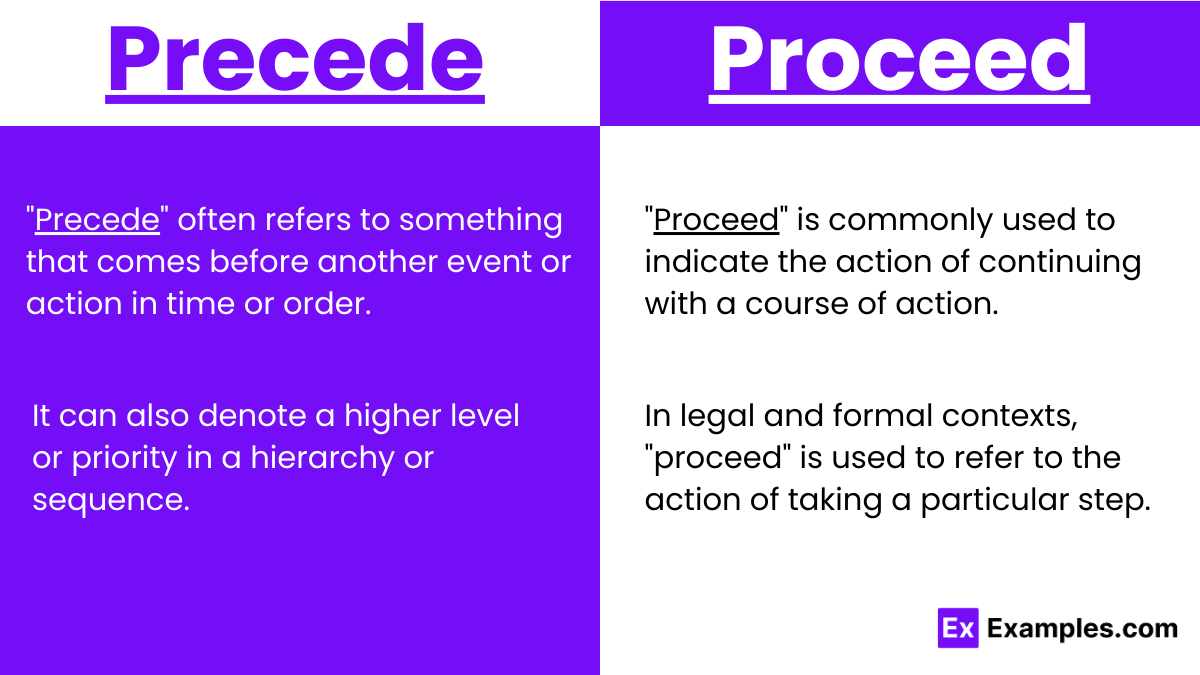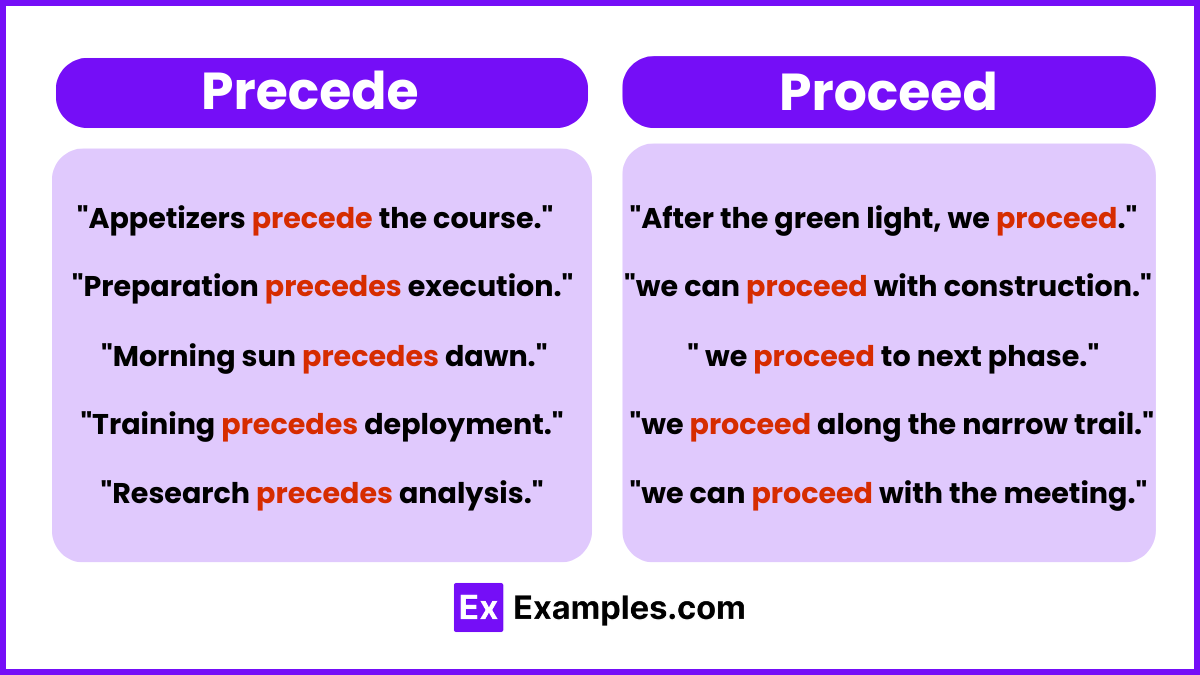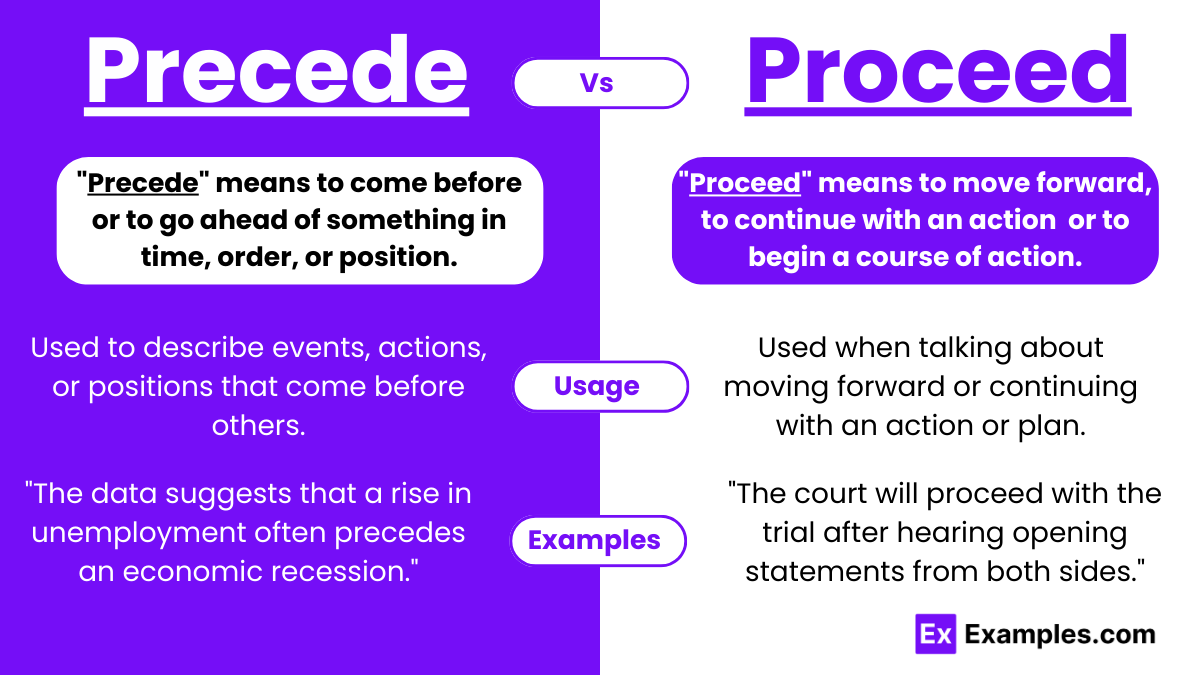Precede vs Proceed – Difference, Meanings, Examples, Usage
In everyday language, “precede” and “proceed” might sound similar, but they carry entirely different meanings. “Precede” refers to something coming before in time, order, or position. On the other hand, “proceed” means to move forward or to continue with a course of action. Despite their phonetic resemblance, these words cannot be interchanged. For instance, events can precede one another, but you proceed with a plan.
Precede and Proceed – Meanings
- “Precede” means to come before or to go ahead of something in time, order, or position. It implies preceding or leading the way.
- “Proceed” means to move forward, to continue with an action, or to begin a course of action. It indicates advancing or carrying on with something, often implying a subsequent action or progression.
Summary
“Precede” and “proceed” are homophones, meaning they sound alike but have distinct meanings and usages. “Precede” indicates something coming before in time or order, while “proceed” denotes moving forward or continuing with an action. In a short way, “Precede” is about what comes before, while “proceed” is about what comes after or what moves forward.
How to Pronounce Precede and Proceed
- Precede: Pronounced as /prɪˈsiːd/ (rhymes with “seed”)
- Proceed: Pronounced as /prəˈsiːd/ (rhymes with “seed”)
How to Remember the Difference
When distinguishing between the two:
- Precede: Think of the “pre” as something happening before or prior.
- Proceed: The “pro” can be linked to progress or moving forward.
Differences between Precede and Proceed
| Aspect | Precede | Proceed |
|---|---|---|
| Definition | To come before in time, order, or position | To move forward or continue with action |
| Nature | Refers to something happening earlier | Implies movement or progress |
| Usage | Typically used in contexts of sequence or hierarchy | Used when talking about continuing or advancing |
| Application | Describes events, actions, or positions in relation to what comes before | Refers to moving forward or carrying out a plan |
| Physical Action | Implies something occurring before another event or action | Suggests moving ahead or continuing with an action |
| Noun/Verb | Can be both a noun and a verb | Primarily used as a verb |
| Common Contexts | Often used in academic or chronological discussions | Found in procedural or forward-moving contexts |
How to use Precede and proceed

- To use “precede” correctly, identify a situation where something occurs before another event, action, or object. “Precede” is used when describing the action of going before or leading the way in terms of time, order, or position. It often implies a chronological or hierarchical sequence, where one thing comes before another.
- To use “proceed” appropriately, consider a context where there is a continuation or advancement of an action, process, or course of events. “Proceed” indicates moving forward or carrying on with something, often after a preceding action has occurred or as part of a planned sequence. It emphasizes the action of continuing with a task or activity.
When to Use Precede and Proceed
Precede
- Sequence or Hierarchy: Used to describe events, actions, or positions that come before others.
- Chronological Discussions: Often found in academic or historical contexts when discussing the order of events.
- Anticipation: Employed to anticipate or forecast what will happen next, based on what has already occurred.
Proceed
- Action and Progress: Used when talking about moving forward or continuing with an action or plan.
- Procedures and Instructions: Found in contexts where instructions or steps need to be followed sequentially.
- Legal or Formal Processes: Applied in legal proceedings or formal protocols where a series of steps must be adhered to.
Examples – Precede and Proceed

Precede Examples
- The appetizer will precede the main course during dinner.
- In history, the Renaissance period preceded the Industrial Revolution.
- A thorough analysis should always precede making any decisions.
- The data suggests that a rise in unemployment often precedes an economic recession.
Proceed Examples
- After finishing their meal, they proceeded to pay the bill.
- The project cannot proceed until we receive approval from the stakeholders.
- Once the paperwork is completed, we can proceed with the construction plans.
- The court will proceed with the trial after hearing opening statements from both sides.
Synonyms
| Precede (noun/verb) | Proceed (verb) |
|---|---|
| Come before | Advance |
| Lead | Continue |
| Antecede | Move forward |
Exercise
- She decided to ___ with the project despite the setbacks.
- The introduction will ___ the main discussion in the presentation.
- After the initial planning stage, they were ready to ___ with the implementation.
- Proper planning should always ___ action in complex projects.
- The graduation ceremony will ___ the end of the academic year.
Answers
- Proceed
- Precede
- Proceed
- Precede
- Proceed
FAQ’S
Does proceed mean before or after?
Proceed typically means to move forward or continue with an action or process, implying after a previous step or event.
What are some examples of precede?
Examples of precede include introduction preceding the main body of a text, sunrise preceding daytime, and preparation preceding a performance.
Does precede mean immediately before?
Yes, precede means to come before something else in time, order, or rank, often implying immediate or direct succession.
Does time proceed or precede?
Time proceeds, meaning it advances or moves forward. Events or moments in time precede when they come before others.
How do you use precede and proceed in a sentence?
Example: “First, the appetizer will precede the main course. Then, we’ll proceed with dessert.” Each step follows the one precedings.


